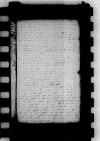Letter #1762
Ioannes DANTISCUS to [Tiedemann GIESE]Löbau (Lubawa), 1537-11-03
English register: Dantiscus informs Giese about the visit to Lubawa of Hermann Bremer, plenipotentiary of Maurycy Ferber’s heirs, who tried to persuade Dantiscus to agree to Johann von Werden’s wishes. Having been refused, Bremer returned to Przezmark, taking Dantiscus’ letter to the testamentary executors with him. Dantiscus encloses a copy of this letter so that Giese and his colleagues (the Warmia canons) will know what line of conduct to take. Dantiscus also informs him that the letter received from Johann von Werden (letter from Przezmark, October 31, 1537) contains no reaction to Dantiscus’ decision sent through Hermann Bremer. Giese’s brother, who brought Dantiscus Werden’s letter, has left Dantiscus 1000 Hungarian florins and is returning to Przezmark today. Dantiscus is sending Giese a copy of the reply to the letter sent by the Prussian Council from Grudziądz to the king. He also encloses letters received from the Cracow bishop and Nipszyc. Dantiscus informs Giese that following the talks Dantiscus’ brother Bernard (von Höfen) held with Iacobus (Ludovicus Decius), it has been decided that the money will be transferred to Rome through the Fuggers’ bank for security reasons. As soon as he gets well, Bernard will deliver the money to Iacobus in Toruń, and then leave immediately for Cracow to hold talks with Georg Hegel on this matter. He will also make sure that, if the Grand Chancellor (Jan Chojeński) goes to the Roman king (Ferdinand I Habsburg) on a mission, the Vice-Chancellor (Paweł Wolski) will post the king’s letter to the pope, written by Giese. Postscript: Dantiscus informs Giese that he has posted a reply to the congratulatory letter to them both, personally written and sent to them by Duke Albrecht. He encourages Giese to reply to Albrecht as well.
Manuscript sources:
Prints:
| ||||||||||||||
Text & apparatus & commentary Plain text Text & commentary Text & apparatus
Reverendissime Domine, Frater et Amice carissime ac honorande. Salutem et fraterni amoris commendationem.
Post abitum
Reverendissimae Dominationis Vestrae integerrimus frater
Postscript:
Quibus modis nobis utrisque
[1 ] On October 27, 1537 Dantiscus received Werden’s letter from Przezmark, mentioned here and dated October 26, 1537 (German orig. cf.
[2 ] Dantiscus is referring to the letter cf.
[3 4 ] Tiedemann Giese had six brothers: Albrecht (b.1474), Martin (b.1476), Michael (b.1477), Eberhard (1479-1508), Hermann (b.1484) and
[5 ] Doubtless this is a reference to cf.
[6 ] Doubtless Dantiscus is sending Giese cf.
[7 ] Dantiscus is writing here about his and Giese’s money, for paying the annates. Fees for church benefices – annates – were introduced in 1316 by Pope John XXII. The beneficiary’s formal pledge to pay the annates was the necessary condition of receiving a provision bulla for the new office. Starting from the Council of Constance (1414-1418), annates from higher-ranking benefices were to be paid in two annual installments at the Apostolic Camera in Rome. The amount of annates was specified for every benefice, though information was also gathered about the actual situation of each beneficiary and analyzed at the consistory during which the provision
was to be settled, and this is doubtless where Dantiscus saw a chance for reducing the fee (cf. Dudziak; further references there). Applications for a reduction to the fee seem to have been widespread at the time, as shown, for example, by the Polish episcopate’s letters to the pope in 1537 (cf. cf. Vetera Monumenta Poloniae et Lithuaniae Gentiumque finitimarum historiam illustrantia maximam partem nondum edita ex Tabulariis Vaticanis deprompta, collecta ac serie chronologica disposita ab Augustino Theiner (1410-1572), vol. 2, ed. by Augustin Theiner, Romae, 1861 ⌊VMPLcf. Vetera Monumenta Poloniae et Lithuaniae Gentiumque finitimarum historiam illustrantia maximam partem nondum edita ex Tabulariis Vaticanis deprompta, collecta ac serie chronologica disposita ab Augustino Theiner (1410-1572), vol. 2, ed. by Augustin Theiner, Romae, 1861 ⌋, No. DLXXX, DLXXXI, p. 520-523). See also cf.
